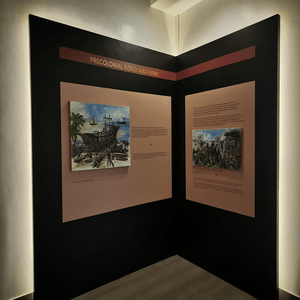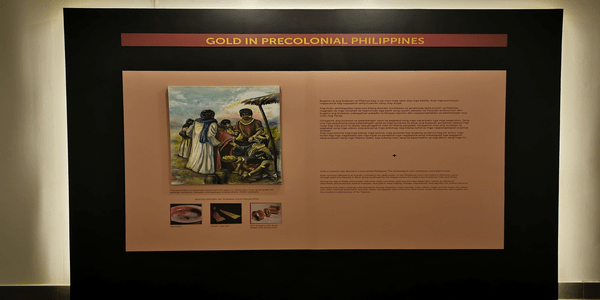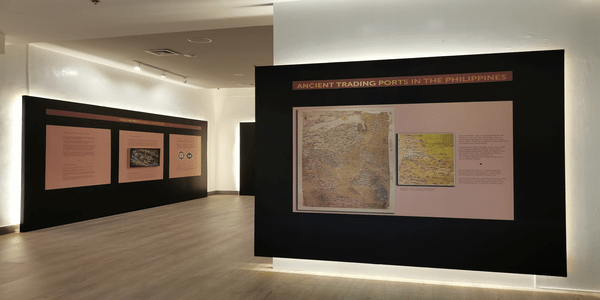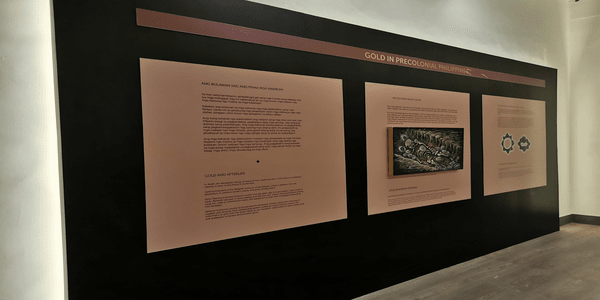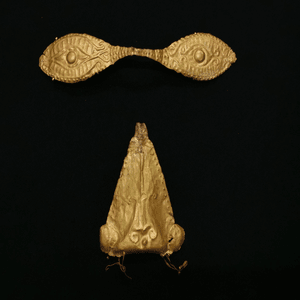| ‹ | Oton Gold Death Mask Gallery |
› |
|---|
“Ang Tamung nga Bulawan: Oton Gold Death Mask, a National Cultural Treasure” is a temporary exhibition that celebrates the homecoming of the Oton Gold Death Mask to Iloilo, half a century after its discovery in San Antonio, Oton, Iloilo.
Dated to late 14th to early 15th century (Age of Trade), the Oton Gold Death Mask is one of the few funerary gold masks and face covers found in the Philippines, and in graves in Bali, Indonesia (100 BC to 100 AD), Vietnam (100 BCE-100 CE), and southern India (Iron Age). Its discovery was celebrated because it was found in situ on June 5, 1967, during the systematic archaeological excavations led by NM anthropologists Alfredo Evangelista and F. Landa Jocano, an Ilonggo. The gold death mask was decorated with repousse dots and curvilinear motifs for both the eye and nose covers.
The burying of the dead with face covers is an ancient burial practice. The early Bisayans believed that the gold coverings in the eyes, nose and mouth protect the dead from evil spirits who want to occupy the dead body. They believed that the brightness of the gold drives away the evil spirits. Gold was also associated with social status, and persons with high ranks were buried with as much gold as possible – gold face covers, small gold in between the burial shroud, gold accessories, jewelry, and beads, and other prized possessions like ceramics.
Some metal age burials in Indonesia, particularly in Bali and Sulawesi were also found with gold death masks, although the beliefs associated to the practice were different compared to that of the Bisayans. Gold masks were also recovered in burial sites in Vietnam while those found in China were made of gold, bronze and even jade. Scholars argued that the death masks and face covers found in Bali and Philippines were evidences of the specialized use of gold in burial practice. The practice of covering faces with gold masks is traceable in burials over a period of 1,700 years.
The Oton Gold Death Mask Gallery is an exhibit in the National Museum Western Visayas that features the Oton gold death mask, an important artifact from the Philippines' pre-colonial era. The death mask is made of gold and was found in a burial site in Oton, Iloilo in 1972.
The exhibit showcases the death mask, which is considered to be one of the most significant archaeological discoveries in the Philippines. It is believed to have been created during the 14th century, and is thought to have been used by a high-ranking individual in the community as a burial ornament.
The death mask is made of a thin sheet of gold, and features intricate designs that reflect the culture and beliefs of the people who created it. It is believed to be a representation of the individual's status and wealth, as well as a symbol of their connection to the spiritual world.
The Oton Gold Death Mask Gallery is known for its unique and valuable display of this important artifact from the Philippines' pre-colonial era. It provides visitors with an opportunity to see and appreciate the artistry and cultural significance of the death mask, and highlights the importance of preserving and studying these artifacts for future generations.
The exhibit is located at Gallery 2 of National Museum Western Visayas.
